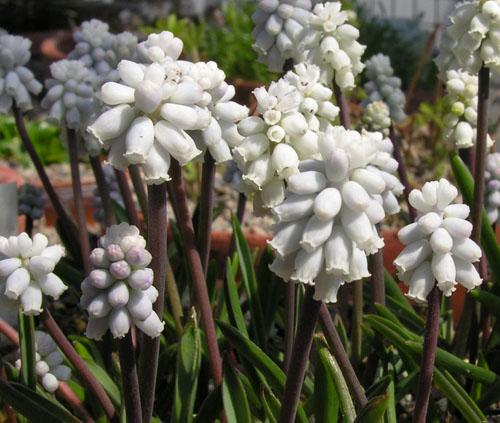Muscari pallens: Red Data Book of Armenia

EN B 1 ab(i,ii,iii,iv) + 2 ab(i,ii,iii,iv)
Category. Endangered species. Endemic of the Caucasus. In Armenia it occurs in two floristic regions. The extent of occurrence is less than 5000 km2, the area of occupancy is less than 500 km2. It was included in the first edition of the Red Data Book of Armenia under Category 1: Endangered species. It is not included in the Annexes of CITES and that of the Bern Convention.
Description. Perennial herb 10–17 cm. Bulb ovate; external tunics brown. Scape 3–5 mm long, elongating after flowering. Basal leaves linear, slightly coriaceous. Inflorescence a dense, short raceme. Perianth of fertile flowers with weak constriction, almost white or pale blue. Capsule 4—5 mm in diameter. Seeds black.
Distribution. In Armenia it grows in Idjevan (between Idjevan and Dilijan) and Sevan (surroundings of Sotk) floristic regions. EOO is 890 km2, AOO is 16 km2, the number of locations is 3. The general area of distribution includes the Greater Caucasus, Dagestan, West, Central and South Transcaucasia.
Ecological, biological and phytocoenological peculiarities. Grows from lower to upper mountain belt, at the altitudes of 800–2100 meters above sea level, in stony and rocky places, in the forests. Flowering from March to April, fruiting in May.
Limiting factors. Restricted extent of occurrence and area of occupancy, loss/degradation of habitats caused by expansion of Sotk gold mining enterprises.
Conservation actions. No conservation actions. Necessary: monitoring of the population state.
Suggestions
 The Ministry of Environment sent a letter international partners to draw their attention to the real danger of environmental disasters as a result of Azerbaijan's large-scale aggression towards the territory of Armenia
The Ministry of Environment sent a letter international partners to draw their attention to the real danger of environmental disasters as a result of Azerbaijan's large-scale aggression towards the territory of Armenia
 Vicia pisiformis: Red Data Book of Armenia
Vicia pisiformis: Red Data Book of Armenia
 Vavilovia formosa: Red Data Book of Armenia
Vavilovia formosa: Red Data Book of Armenia
 Trigonella capitata: Red Data Book of Armenia
Trigonella capitata: Red Data Book of Armenia
 Trigonella astroides: Red Data Book of Armenia
Trigonella astroides: Red Data Book of Armenia












